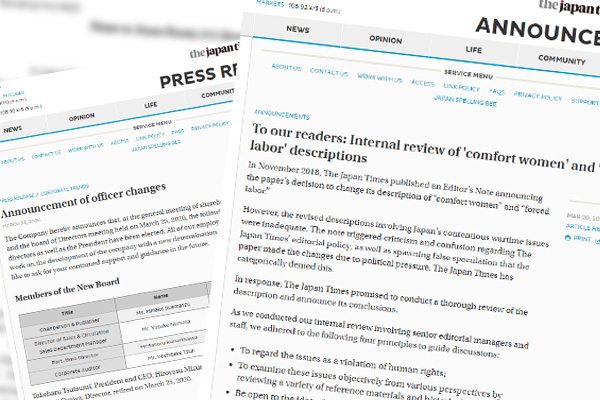The Japan Times, an English daily in Japan, in a half-page announcement on March 20 said it would revise its description of prewar and wartime “comfort women” again after a revision in November 2018. We are concerned that the decision to revise the description again represents a retreat from a historical fact that the recruitment of comfort women was not forced and an effective return to the old description of comfort women as forced to have sex with Japanese soldiers.
Retaining “wartime laborers”
The daily decided to describe “comfort women” as “women who were forced or coerced into Japan’s wartime brothel system” or “women who suffered under Japan’s military brothel system.” The two descriptions, if combined, become one step closer to the old description of comfort women as “women who were forced to provide sex to Japanese soldiers.”
No objective documents exist to prove authorities’ coercive recruitment of comfort women. The coercive recruitment was also denied by former Seoul University professor Lee Yong Hoon who authored “Anti-Japan Tribalism: The Root of the Japan-South Korea Crisis” that has become a bestseller in Japan as well as in South Korea on its publication in both countries in 2019.
Meanwhile, the Japan Times announcement confirmed to retain its shift in 2018 from “forced laborers” to “wartime laborers” to describe so-called“requisitioned” laborers from the Korean Peninsula in the wartime past, saying that the shift was appropriate.
Executive editor’s resignation is a greater matter of concern
A greater matter of concern than the Japan Times announcement is the resignation of Takeharu Tsutsumi as president and Hiroyasu Mizuno as executive editor as released on March 25. Particularly, Mr. Mizuno has tackled the reform of Japan Times stories that had been leaning left, including the revision of the comfort women description, since he was invited to serve as executive director after Minako Suematsu became chief executive officer upon the newspaper’s sale to online media company News2u in 2017 due to its sluggish performance.
Over the past one year and half, Mr. Mizuno has checked almost all Japan Times stories to correct any bias of the newspaper that had once been branded as “anti-Japan Times.” His editorial policy faced strong inside resistance. Editorial meetings last year were turbulent, according to Reuters, which reported that President Tsutsumi resigned to take the responsibility for the paper’s deteriorating performance.
Japan Times Chairperson and Publisher Suematsu will take up the presidency in April to reconstruct the newspaper. Most of about 130 employees are long-term Japan Times staffers. Leftist foreigners and Japanese reporters could regain their influence on editing. The Japan Times with circulation at about 40,000 copies is smaller than Japanese language papers but has greater overseas influence. Behind the dominant news coverage of coronavirus pandemic, the newspaper could grow anti-Japan and collaborate with Western liberals and leftists, depending on future developments.
Hironobu Ishikawa is a director and Planning Committee member of the Japan Institute for National Fundamentals and a former Washington D.C. correspondent and international news editor of The Yomiuri Shimbun newspaper.


